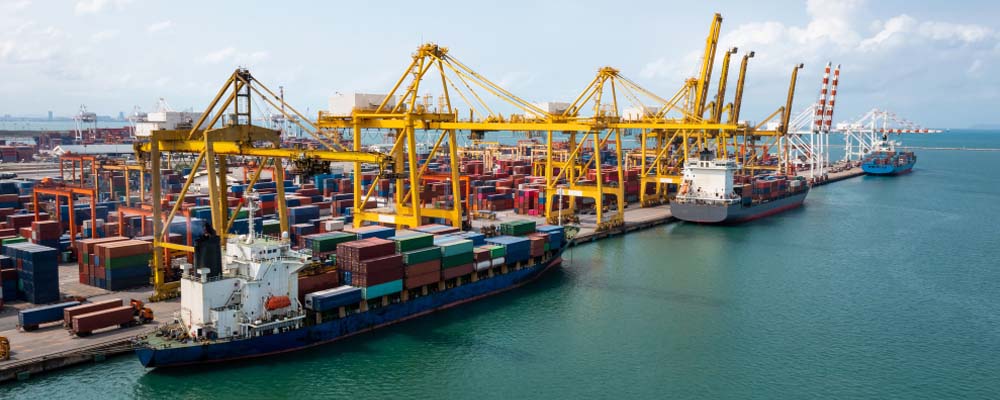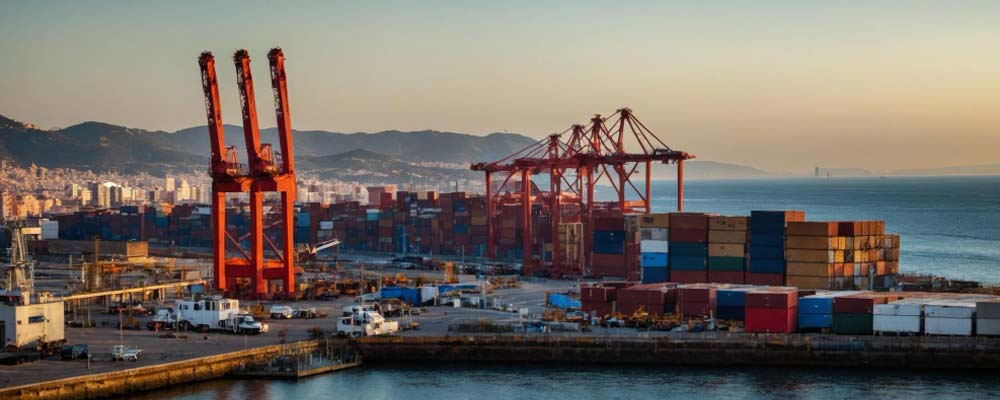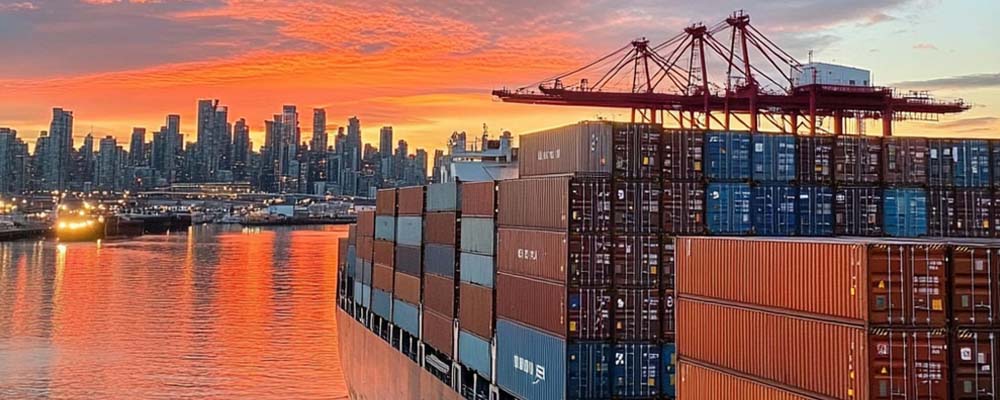
In the world of freight forwarding, logistics, and global trade, understanding the significance of major ports is paramount. For businesses involved in importing, exporting, and supply chain management, the efficiency of your operations can often hinge on the capabilities and strategic positioning of the ports you utilize. Canada, with its extensive coastline and robust maritime infrastructure, offers some of the world’s most efficient and strategic ports. In this blog post, we’ll explore the top 5 major ports in Canada, detailing their unique features and benefits to help you make informed decisions about your logistics operations.
Top 5 Major Ports in Canada
1. Port of Vancouver
Canada’s Busiest Gateway to Asia
The Port of Vancouver stands as Canada’s largest and busiest port, handling a significant portion of the nation’s total trade. Located on the west coast of British Columbia, it serves as a vital gateway for trade with Asia and other international markets. The port’s strategic location and state-of-the-art facilities make it an indispensable hub for businesses looking to streamline their supply chains.
Advanced Facilities and Specialized Terminals
The Port of Vancouver boasts multiple specialized terminals dedicated to various types of cargo, including containers, bulk commodities, and breakbulk goods. These terminals are equipped with advanced logistics and tracking systems that enable businesses to monitor their shipments in real-time, ensuring transparency and reliability throughout the supply chain. This level of detail is crucial for maintaining efficient operations and meeting tight deadlines.
Commitment to Sustainability
In addition to its logistical advantages, the Port of Vancouver is committed to sustainability. The port implements eco-friendly practices and initiatives to reduce its environmental impact, making it a responsible choice for companies that prioritize sustainability. This commitment not only helps protect the environment but also enhances the port’s reputation as a forward-thinking logistics hub.
2. Port of Montreal
Key Gateway for Transatlantic Trade
The Port of Montreal is the second-largest port in Canada and plays a crucial role in the country’s maritime trade. Located in Quebec, it handles a substantial volume of containerized cargo and serves as a key gateway for transatlantic trade. Its central location offers excellent connectivity to Eastern Canada and the Midwest United States, facilitating smooth and efficient trade routes.
Optimized Operations with Advanced Technology
With specialized terminals designed for container handling and other cargo types, the Port of Montreal leverages advanced technology to optimize its operations. Real-time tracking systems provide businesses with accurate updates on their shipments, ensuring timely deliveries and enhancing customer satisfaction. This technological edge is a significant factor in the port’s ability to handle high volumes of cargo efficiently.
Infrastructure and Sustainability Investments
The port’s ongoing investments in infrastructure and sustainability initiatives further enhance its appeal as a reliable and eco-friendly logistics hub. By continuously upgrading its facilities and adopting green practices, the Port of Montreal ensures it remains at the forefront of the maritime industry, offering businesses a modern and responsible port option.
 3. Port of Prince Rupert
3. Port of Prince Rupert
North America’s Closest Port to Asia
The Port of Prince Rupert is one of Canada’s fastest-growing ports, known for its strategic location as the closest North American port to Asia. Located in British Columbia, it specializes in container traffic and bulk commodities such as coal and grain. The port’s deep-water harbor and modern facilities make it an efficient hub for international trade, providing businesses with a competitive edge.
Seamless Cargo Handling and Monitoring
Prince Rupert’s advanced terminals and tracking systems allow for seamless cargo handling and real-time shipment monitoring, ensuring reliability and transparency for businesses. This high level of efficiency is crucial for maintaining smooth operations and minimizing delays, which can be costly in the logistics industry.
Environmental Stewardship
The port’s commitment to sustainability and environmental stewardship further positions it as a forward-thinking choice for global trade. By implementing eco-friendly practices and reducing its environmental footprint, the Port of Prince Rupert not only supports environmental conservation but also enhances its attractiveness to eco-conscious businesses.
4. Port of Halifax
Strategic Atlantic Gateway
The Port of Halifax is the largest port on Canada’s East Coast, renowned for its deep-water, ice-free harbors. Located in Nova Scotia, it handles a diverse range of cargo, including containers, bulk carriers, and cruise ships. The port’s strategic location makes it an essential gateway for Atlantic trade, offering excellent connectivity to global markets and serving as a vital link in the supply chain.
Cutting-Edge Technology for Efficient Operations
Halifax’s terminals are equipped with cutting-edge technology to ensure efficient cargo handling and storage. Comprehensive tracking systems provide businesses with real-time updates on their shipments, enhancing reliability and customer satisfaction. These technological advancements make the Port of Halifax a highly efficient and dependable option for businesses involved in international trade.
Dedication to Environmental Sustainability
The port’s dedication to sustainability and reducing its environmental footprint makes it an attractive option for eco-conscious companies. By adopting green practices and investing in sustainable infrastructure, the Port of Halifax demonstrates its commitment to environmental responsibility, aligning with the values of many modern businesses.
5. Port of Saint John
Key Player in Atlantic Trade
The Port of Saint John, located in New Brunswick, is a significant player in Canada’s Atlantic trade. It handles a wide variety of cargo, including containers, bulk, and breakbulk goods, and plays a key role in the energy sector, particularly in the import and export of petroleum products. The port’s strategic location and modern infrastructure enable efficient operations and strong connectivity to both domestic and international markets.
Specialized Terminals and Advanced Tracking
With specialized terminals for different types of cargo and advanced tracking systems, the Port of Saint John ensures seamless logistics and real-time shipment monitoring. These features are crucial for maintaining efficient supply chain operations and meeting the diverse needs of businesses.
Focus on Sustainability and Eco-Friendly Practices
The port’s focus on sustainability and eco-friendly practices further enhances its reputation as a responsible and reliable choice for businesses engaged in global trade. By prioritizing environmental stewardship, the Port of Saint John aligns with the growing demand for sustainable logistics solutions.
 Benefits of Utilizing Canadian Ports
Benefits of Utilizing Canadian Ports
Strategic Locations
Canadian ports are strategically located along major trade routes, providing excellent connectivity to global markets. This advantage allows businesses to optimize their supply chains and reduce transit times, enhancing overall efficiency.
Advanced Technology and Infrastructure
The ports in Canada are equipped with advanced technology and modern infrastructure, ensuring efficient cargo handling and real-time tracking. These features are essential for maintaining smooth operations and meeting the demands of the logistics industry.
Commitment to Sustainability
Many Canadian ports are committed to sustainability and environmental stewardship, making them attractive options for businesses that prioritize eco-friendly practices. By choosing these ports, companies can reduce their environmental impact and align with the growing demand for sustainable logistics solutions.
Logistics Tips for Using Canadian Ports
Plan Ahead
Effective planning is crucial for optimizing logistics operations. Businesses should plan their shipments well in advance, considering factors such as transit times, port capacities, and potential delays. This proactive approach helps ensure smooth and efficient operations.
Leverage Technology
Utilize the advanced technology and tracking systems offered by Canadian ports to monitor your shipments in real-time. This capability provides valuable insights into the status of your cargo, allowing you to make informed decisions and address any issues promptly.
Collaborate with Partners
Collaborate with logistics providers, customs brokers, and other partners to streamline your operations and enhance efficiency. Building strong relationships with these stakeholders can help ensure successful and timely shipments.
FAQs About Ports in Canada
What are the main benefits of using Canadian ports for international trade?
Canadian ports offer strategic locations, advanced technology, and a commitment to sustainability, making them ideal for optimizing logistics operations and reducing transit times.
How do Canadian ports ensure the efficiency of cargo handling?
Canadian ports are equipped with modern infrastructure and advanced tracking systems, ensuring efficient cargo handling and real-time monitoring of shipments.
What sustainability initiatives are Canadian ports implementing?
Many Canadian ports are adopting eco-friendly practices and investing in sustainable infrastructure to reduce their environmental impact and support environmental conservation.
 Conclusion
Conclusion
Understanding the capabilities and strategic advantages of Canada’s major ports is essential for businesses involved in global trade. From the bustling Port of Vancouver to the rapidly growing Port of Prince Rupert, these ports offer advanced technology, strategic locations, and a commitment to sustainability. By leveraging the strengths of these ports, businesses can optimize their logistics operations, enhance efficiency, and reduce their environmental footprint.
For those looking to further refine their logistics strategies and learn more about Canada’s major ports, don’t hesitate to reach out to us. Together, we can ensure your supply chain remains robust, efficient, and sustainable in the dynamic world of global trade.




 3. Port of Prince Rupert
3. Port of Prince Rupert Benefits of Utilizing Canadian Ports
Benefits of Utilizing Canadian Ports Conclusion
Conclusion



